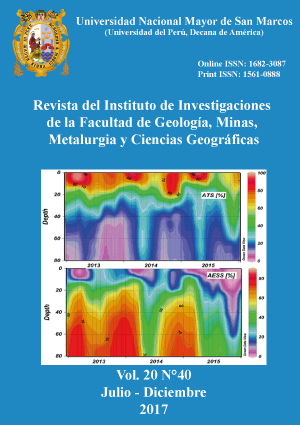Space-Temporal variability of fitoplancton and oceanographic variables in The Gulf of Guayaquil during 2013-15
DOI:
https://doi.org/10.15381/iigeo.v20i40.14392Keywords:
Phytoplankton, Ocanography, Nutrients, Estuary, Mariculture, El NiñoAbstract
The Gulf of Guayaquil is the main tropical estuary of the Southeast Pacific, has ecological and economic importance. Its oceanographic variability is regulated by seasonal fluctuations in wet and dry seasons. The study area is a fixed station northeast of Santa Clara Island in the Gulf of Guayaquil, in a water column (0-75m), with a monthly frequency for 3 years (2013 to 2015), applying standardized methodologies for the Collection of oceanographic samples (temperature, salinity, nitrate and phosphate) and phytoplankton (functional groups - main species). The results showed warmer waters between March and May, being more evident in the last of 2015, related to the event El Niño-Southern Oscillation (ENSO). Salinity was a more stable parameter in the water column. The distribution and concentration of oxygen, presented a surface layer with high concentration and another subsuperfical layer with lower oxygen. The nitrate was the nutrient with greater significant contribution and with greater variability than the phosphate and silicate. The structure and distribution of phytoplankton recorded 166 species during the 3 years; 32 species were more abundant and corresponded to diatoms. Its abundance and diversity was dependent on depth. At subsurface level, there was no differentiation in the 3 years. The relationship of phytoplankton with oceanographic conditions was statistically significant, with sporadic abundances of diatoms (Skeletonema costatum, Nitzschia longissima, Chaetoceros curvisetus, C. affinis, C. didymus) on the surface layer, with few dinoflagellates. The maxima were located in the vicinity of thermocline and nutricline. Gymnodinium and Gyrodinium (dinoflagellates) and ciliated Myrionecta rubra were frequent. The abundance of diatoms indicated the good food sustainability in the Gulf, evidencing that the El Niño thermal conditions were relatively weak on the primary producers.Downloads
Published
Issue
Section
License
Copyright (c) 2017 Gladys Torres, Sonia Recalde, Richard Narea, Willington Renteria, Luis Troccoli, Oscar Tinoco

This work is licensed under a Creative Commons Attribution-NonCommercial-ShareAlike 4.0 International License.
AUTHORS RETAIN THEIR RIGHTS:
a. Authors retain their trade mark rights and patent, and also on any process or procedure described in the article.
b. Authors retain their right to share, copy, distribute, perform and publicly communicate their article (eg, to place their article in an institutional repository or publish it in a book), with an acknowledgment of its initial publication in the Rev. Inst. investig. Fac. minas metal cienc. geogr.
c. Authors retain theirs right to make a subsequent publication of their work, to use the article or any part thereof (eg a compilation of his papers, lecture notes, thesis, or a book), always indicating the source of publication (the originator of the work, journal, volume, number and date).






